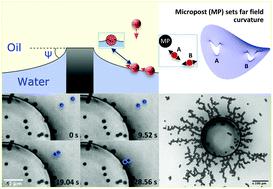当前位置:
X-MOL 学术
›
Soft Matter
›
论文详情
Our official English website, www.x-mol.net, welcomes your
feedback! (Note: you will need to create a separate account there.)
Dimerization and structure formation of colloids via capillarity at curved fluid interfaces.
Soft Matter ( IF 2.9 ) Pub Date : 2020-06-12 , DOI: 10.1039/d0sm00557f Alismari Read 1 , Sreeja Kutti Kandy 1 , Iris B Liu 1 , Ravi Radhakrishnan 1 , Kathleen J Stebe 1
Soft Matter ( IF 2.9 ) Pub Date : 2020-06-12 , DOI: 10.1039/d0sm00557f Alismari Read 1 , Sreeja Kutti Kandy 1 , Iris B Liu 1 , Ravi Radhakrishnan 1 , Kathleen J Stebe 1
Affiliation

|
Capillary interactions are ubiquitous between colloids trapped at fluid interfaces. Generally, colloids in fluid interfaces have pinned, undulated contact lines that distort the interface around them. To minimize the area, and therefore the energy of these distortions, colloids interact and assemble in a manner that depends on the shape of the host interface. On curved interfaces, capillary interactions direct isolated colloid motion along deviatoric curvature gradients. This directed motion relies on the leading order, long-ranged quadrupolar distortions made by the colloids' undulated pinned contact lines. Here we study pair interactions and dimer formation of colloids on non-uniformly curved fluid interfaces. Pair interaction energies are inferred to be order of 104kBT, and interacting forces are of order 10−1 pN for 10 micron particles adsorbed on interfaces formed around a 250 micron micropost. We compare experiments to analysis for the pair interaction energy, and identify criteria for dimers to form. We also study the formation of trapped structures by multiple particles to discern the influence of the underlying interface shape and the contact line undulations. By comparison to Monte Carlo simulations with potentials of interactions based on analysis, we find that higher order terms in the distortion fields generated by the particles play a major role in the structure formation on the curved interface. These interactions are determined by the particle's contact line and the host interface shape, and can be used to assemble particles independent of their material properties.
中文翻译:

胶体通过弯曲流体界面处的毛细作用的二聚化和结构形成。
毛细管相互作用在流体界面处捕获的胶体之间无处不在。通常,流体界面中的胶体具有固定的,起伏的接触线,使它们周围的界面变形。为了最小化面积,并因此最小化这些变形的能量,胶体以取决于宿主界面形状的方式相互作用和组装。在弯曲的界面上,毛细管相互作用沿着偏曲率梯度引导孤立的胶体运动。这种有向的运动依赖于由胶体起伏的固定接触线引起的前导,远距离的四极畸变。在这里,我们研究非均匀弯曲的流体界面上胶体的配对相互作用和二聚体形成。配对相互作用能推断为10 4 k B T的量级,并且相互作用力的大小为10 -1吸附在250微米微柱周围形成的界面上的10微米颗粒的pN。我们比较实验以分析对相互作用能,并确定形成二聚体的标准。我们还研究了由多个粒子形成的陷阱结构,以识别潜在的界面形状和接触线起伏的影响。通过与基于分析的相互作用潜能的蒙特卡洛模拟进行比较,我们发现粒子产生的畸变场中的高阶项在弯曲界面上的结构形成中起主要作用。这些相互作用是由粒子的接触线和主体界面的形状决定的,可用于组装与粒子的材料特性无关的粒子。
更新日期:2020-07-01
中文翻译:

胶体通过弯曲流体界面处的毛细作用的二聚化和结构形成。
毛细管相互作用在流体界面处捕获的胶体之间无处不在。通常,流体界面中的胶体具有固定的,起伏的接触线,使它们周围的界面变形。为了最小化面积,并因此最小化这些变形的能量,胶体以取决于宿主界面形状的方式相互作用和组装。在弯曲的界面上,毛细管相互作用沿着偏曲率梯度引导孤立的胶体运动。这种有向的运动依赖于由胶体起伏的固定接触线引起的前导,远距离的四极畸变。在这里,我们研究非均匀弯曲的流体界面上胶体的配对相互作用和二聚体形成。配对相互作用能推断为10 4 k B T的量级,并且相互作用力的大小为10 -1吸附在250微米微柱周围形成的界面上的10微米颗粒的pN。我们比较实验以分析对相互作用能,并确定形成二聚体的标准。我们还研究了由多个粒子形成的陷阱结构,以识别潜在的界面形状和接触线起伏的影响。通过与基于分析的相互作用潜能的蒙特卡洛模拟进行比较,我们发现粒子产生的畸变场中的高阶项在弯曲界面上的结构形成中起主要作用。这些相互作用是由粒子的接触线和主体界面的形状决定的,可用于组装与粒子的材料特性无关的粒子。











































 京公网安备 11010802027423号
京公网安备 11010802027423号